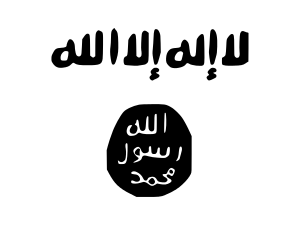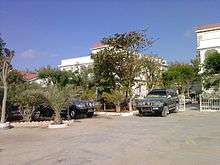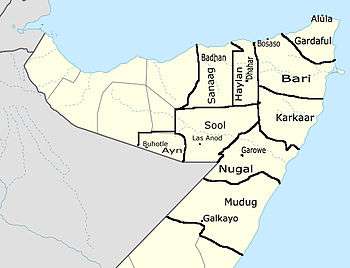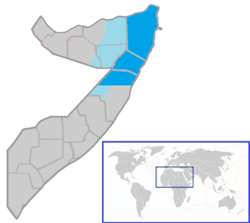Islamic State in Somalia
| Islamic State in Somalia | |
|---|---|
|
Wilayat al Somal Participant in the War in Somalia | |
 The Black Standard of the Islamic State of Iraq and the Levant. | |
| Active | October 2015[1]–present |
| Ideology |
Salafist Islamism Salafist Jihadism Anti-Christian[2] |
| Leaders |
Abu Bakr al-Baghdadi (self-proclaimed caliph of ISIL) Sheikh Abdul Qadir Mumin[1] (leader of ISS) Mahad Maoallim[3] (ISS senior commander) Mohamed Dulyadin[4] (ISS senior commander) |
| Headquarters | Galaga mountains[1] |
| Area of operations | Somalia |
| Size | 100[4]–300[5] |
| Part of |
|
| Allies |
|
| Opponents |
|
| Battles and wars | |
The Islamic State in Somalia (short: ISS) or Abnaa ul-Calipha is an Islamic State of Iraq and the Levant-affiliated group that primarily operates in the mountainous areas of Puntland, though has also claimed responsibility for several terrorist attacks throughout the rest of Somalia. Led by Sheikh Abdul Qadir Mumin, the group is estimated to have up to 300 active fighters. Since its formation, ISS probably managed to take control of a small, sparsely populated territory in northern Somalia's mountainous hinterland, though it was not acknowledged as official province ("Wilayat") by ISIL's central leadership until December 2017. Since then, it has sometimes been called Wilayat al Somal ("Somalia Province") by pro-ISIL media. ISS is also the declared enemy of al-Shabaab, which considers the Islamic State a significant threat to its own predominance among Jihadist factions in Somalia.
History
Origins and formation
The origins of the Islamic State in Somalia trace back to 2012, when Abdul Qadir Mumin was sent by the al-Shabaab leadership to its remote outpost in Puntland, far from the terrorist group's primary areas of operation in southern Somalia. As cleric with little military experience, Mumin's role in Puntland was originally to attract recruits for the numerical small and militarily weak local al-Shabaab group, which was led by Mohamed Said Atom at the time. In course of the Galgala campaign in 2014, however, Atom defected to the government, and Mumin was forced to take control of the Puntland group. Isolated in the remote north and feeling increasingly distanced from al-Shabaab, Mumin began to consider himself more and more independent.[1]
Meanwhile, the Islamic State of Iraq and the Levant had launched a propaganda campaign to convince al-Shabaab to join to them, which was "angrily refused" by al-Shabaab's central leadership.[1] Despite this, several groups of al-Shabaab members found ISIL's ideology attractive or saw this new Jihadist organization as a way to challenge al-Shabaab's leadership at the time. Thus, several small pro-ISIL groups emerged in southern Somalia. This was however not tolerated by the Somali organization, which released statements condemning dissenters[lower-alpha 1] and ordered its internal security service Amniyat to arrest or kill pro-ISIL elements such as Hussein Abdi Gedi's faction in Middle Juba.[8]
Mumin, however, long dissatisfied with his situation, pledged bay'ah to Abu Bakr al-Baghdadi and the Islamic State in October 2015. This caused a violent split within Puntland's al-Shabaab, as only 20 of the 300 local Islamist fighters joined Mumin,[1][9] while the al-Shabaab loyalists attempted to kill these defectors. Mumin's small group proceeded to form Abnaa ul-Calipha, better known as Islamic State in Somalia, and to evade their erstwhile comrades, while recruiting new members for their cause.[5] It should be noted that al-Baghdadi and the ISIL leadership did not acknowledged Mumin's bay'ah, instead choosing to wait and see how the Islamic State in Somalia fared.[1] While Mumin's group in the north thus managed to survive, the situation of pro-ISIL forces in southern Somalia consequently became even more precarious. In two notable incidents in November and December 2015, al-Shabaab attacked and destroyed two of the most important southern ISIL cells, namely the ones of Bashir Abu Numan and Mohammad Makkawi Ibrahim. Pro-government forces such as the Somali Armed Forces and Ahlu Sunna Waljama'a also claimed to have targeted southern ISIL groups. As result, ISIL forces in southern Somialia remained very weak,[10] and those that survived appear to have accepted Mumin's authority over time, formally becoming part of ISS.[11]
Rise in power and Qandala campaign

In March 2016, an ISS cell in southern Puntland was pursued by al-Shabaab fighters into Mudug; the pursuers were however attacked and completely defeated by the Puntland Dervish Force and Galmudug soldiers, thus unintentionally allowing the Islamic State militants to escape into safety.[13] Over the following months Mumin's followers built up their strength, and by April 2016 they had set up a temporary training camp named after Bashir Abu Numan, the ISIL follower mentioned above who had been killed by al-Shabaab in November 2015.[12][8] In one of the group's propaganda videos, Mumin blessed the makeshift base as the "first camp of the Caliphate in Somalia". On 25 April, ISS also carried out its first attack on government forces, when one of its fighters detonated an IED against an AMISOM vehicle in Mogadishu.[12] By August 2016, Mumin's cell still remained very small, probably under 100 militants, and was not yet very active. According to the United States Department of State, however, ISS began to expand in size by abducting and indoctrinating boys between 10 and 15 and employing them as child soldiers.[14]
By October 2016, ISS had claimed less than one dozen attacks overall since its foundation, showing that the group was still relatively weak. Nevertheless, the fact that many of these strikes had taken place in Mogadishu, indicated that ISS had become able to operate throughout wider Somalia, not just in its core regions in Puntland.[9] Experts also estimated that Mumin's cell had significantly grown to up to 300 fighters. On 26 October, the group eventually launched their first major operation by targeting the major port town of Qandala. The town had both symbolic as well as strategic significance, as it could allow ISS to bolster their local support and receive more supplies from Yemen. The Islamic State fighters managed to overrun the town, meeting little resistance, and thereafter controlled it largely unchallenged until 3 December. On that day, the Puntland Security Force launched a counter-offensive, and after sporadic fighting for four days, retook Qandala on 7 December 2016.[5][3][1] Mumin's men were forced to retreat to El Ladid, a village 30 kilometers south of Qandala, where government forces once again attacked and scattered them on 18 December.[15] Overall, ISS suffered numerous casualties during the Qandala campaign,[3] but had scored a symbolic victory nonetheless, having captured and held a major town for more than a month.[1] Having established a new headquarters in the al-Mishkat Mountains, ISS subsequently managed to attract new recruits, mostly children and orphans, though also some new defectors from al-Shabaab.[16] It also became generally more active.[17]
Expanded terrorist attacks and announcement of Wilayat al Somal

Furthermore, the Qandala campaign resulted in the Puntland government as well as the African Union taking ISS more seriously, with both taking more steps to counter ISS' growing strength.[1] On 8 February 2017, ISS launched its next major attack in Puntland, with several militants of the group attacking the Village Hotel in Bosaso. A fierce shootout ensued, with the hotel's guards eventually repelling the attackers. At least four guards and two ISS fighters died during the fighting.[18] On 28 March 2017, ISS ambushed a convoy of Puntland soldiers near Qandala. The attackers retreated into the hills after inflicting two casualties on the government forces.[19] On 16 April, the group occupied Dasan village near Qandala, though abandoned it again after a few hours.[16] ISS was also blamed for a roadside bomb in Galgala on 23 April that killed 8 soldiers and injured 3 others.[20] On 23 May 2017, ISS carried out a suicide bombing, which was possibly the group's very first suicide attack. When the ISS suicide bomber tried to close in on the Juba Hotel in Bosaso, he was stopped at a military checkpoint, causing him to detonate his explosives, killing five and wounding twelve.[21][22]
In June 2017, a Puntland military official claimed that ISS had been reduced to around 70 active fighters, and sustained itself by stealing food and livestock from local communities.[23] Regional expert Matthew Bryden, on the other side, said that ISS still had up to 300 fighters and had become entrenched in the eastern Galaga mountains, where it had gained the support of some local communities which felt ignored by the government.[24] Observers also noted that ISS had significantly increased their output of propaganda material in an attempt to sway disenfranchised locals[16] and international jihadists to their side.[4] By late 2017, the United Nations estimated that Mumin's group was about 200 fighters strong.[25]
In November 2017, the United States launched their first airstrikes on ISS, reportedly killing several members of the group[26][27] in Buqo Valley, east of Bosaso. They failed to kill Mumin, however, who had been the main target of the bombings.[28] Observers noted that these airstrikes indicated that the US military had come to see ISS as considerable threat to the stability of the region.[25] On 25 December, ISIL released an anti-Christian propaganda video under the name "Hunt Them Down, O Monotheists", in which the Islamic State in Somalia was called Wilayat al Somal (Somalia Province), thus seemingly elevating the group to an official province of the proclaimed worldwide caliphate of ISIL.[2] Since then, however, the new name has not been consistently applied to the group by pro-ISIL media.[29]
Meanwhile, ISS started to launch assassination attempts in the region around Mogadishu from November 2017, with the town Afgooye most affected.[29] By May 2018, the group had reportedly carried out eleven attacks and killed 23 people who had allegedly worked for the government, such as intelligence agents, soldiers, officials, and policemen. In response to these assaults, the National Intelligence and Security Agency started to arrest suspected ISS members in and around Mogadishu.[30][31] ISS also abducted nine people the region around Qandala in January 2018, including some off-duty soldiers. The militia later tortured and decapitated at least three of them, leaving them along a road to be found by passerbys.[32]
Organization

The Islamic State in Somalia is led by Abdul Qadir Mumin, whose role for the continued existence of the group has been judged to be extremely important.[33] Described as "eloquent and persuasive, [...] very savvy and sophisticated", Mumin is deeply involved in international jihadism and considered to be an extremely dangerous terrorist leader. After reports circulated in June/July 2017 that Abu Bakr al-Baghdadi had been killed, terror expert Candyce Kelshall even speculated that Mumin might be tempted to declare himself the new caliph of ISIL.[4] Mumin's direct control is however limited to ISS forces in northern Somalia. Though pro-ISIL cells in the southern parts of the country have probably accepted Mumin as their official leader,[11] the exact relationship between the northern and southern groups of ISS remains unclear. It is possible that the latter only have nominal links to the northern branch or no actual contact at all.[7] In any case, the southern cells remain mostly weak and exist in a precarious state, constantly threatened by al-Shabaab.[11] The vast majority of ISS members are Somalis, with only a few foreign mujahideen fighting with group, including at least one Sudanese, a few Yemenis,[34][25] and two Ethiopians.[2]
Though it is probable[34] that ISS controls a relatively small territory in Puntland's mountainous hinterland,[24] the group is not known to have attempted to set up something resembling a government at any point of its existence. ISS' current areas are only very sparsely settled or not populated at all,[34] while Qandala's civilian population completely fled during its occupation by the militants.[35] The group is known to use caves as hiding places.[28]
Propaganda
The propaganda of ISS is generally extremely inferior compared to its direct rival al-Shabaab. The Islamic State in Somalia has no media wing of its own and also has not organized a "robust informal media presence". Instead, it mostly relies on the existing propaganda channels of ISIL, such as the Amaq News Agency.[33] The propaganda video of December 2017 that declared ISS a province, however, also claimed to have been produced by the "Media Office of Wilayat al Somal".[2]
Supply, support and allies
In its endeavor to build up its military strength, the Islamic State in Somalia is aided by the fact that Puntland's government has only limited control over its hinterland while its military is overstrechted. Peripheral areas are thus mostly ignored by the security forces and instead run by rebellious and infighting tribal militias. As result, local clans (including Mumin's own, the Majeerteen Ali Saleban) are aggrieved by their perceived marginalisation by the government and in some cases ready to support ISS. Such dissatisfied elements are the ones from which ISS receives supplies and recruits new members.[13][16] There have also been accounts, however, that ISS raids those communities which do not support it for food and other necessaries,[23] and to kidnap children in order to indoctrinate and train them as child soldiers.[14]
The group is also directly supported by the Islamic State of Iraq and the Levant – Yemen Province, which is known to have sent experts, trainers, money, weapons and other materials to ISS.[5] The United Nations also claimed in November 2017 that ISS receives direct assistance from ISIL officials in Syria and Iraq.[34][25] In smuggling fighters and supplies across the Gulf of Aden, ISS works closely with Somali pirates, namely Mohamed Garfanje's Hobyo-Haradhere Piracy Network and another unidentified group that is based in Qandala. These pirates do, however, also supply ISS' rival in Puntland, al-Shabaab, with weapons and other materials.[6]
Furthermore, ISS has been supported by "financial operative" Mohamed Mire Ali Yusuf (often simply called Mire Ali) who provided the group with money and supplies through two companies, both located in Bosaso by 2016: Liibaan Trading, a livestock trading business, and Al-Mutafaq Commercial Company. The United States Department of the Treasury designated Mire as terrorist and sanctioned his two businesses in February 2018.[36][37]
Notes
- ↑ Al-Shabaab radio stations for example declared in November 2015: "If anyone says he belongs to another Islamic movement [other than that of al-Qa'ida], kill him on the spot ... we will cut the throat of anyone ... if they undermine unity." Al-Shabaab spokesman Ali Mahmud Rage similarly claimed that dissenters in the organization were "infidels" who would be "burnt in hell".[7]
References
- 1 2 3 4 5 6 7 8 9 10 Warner (2017), p. 30.
- 1 2 3 4 Thomas Joscelyn; Caleb Weiss (27 December 2016). "Islamic State video promotes Somali arm, incites attacks during holidays". Long War Journal. Retrieved 30 December 2017.
- 1 2 3 Harun Maruf (7 December 2016). "Forces Retake Somali Town Held by Pro-Islamic State Fighters". Voice of America. Retrieved 10 February 2017.
- 1 2 3 4 Marco Giannangeli (16 July 2017). "British jihadi bids to be leader of Islamic State". Daily Express. Retrieved 7 August 2017.
- 1 2 3 4 5 Harun Maruf (28 October 2016). "Somali Officials Vow to Retake Puntland Town". Voice of America. Retrieved 10 February 2017.
- 1 2 Robyn Kriel; Briana Duggan (10 July 2017). "CNN Exclusive: Somali pirate kings are under investigation for helping ISIS and al-Shabaab". CNN. Retrieved 7 August 2017.
- 1 2 Warner & Weiss (2017), p. 28.
- 1 2 Warner & Weiss (2017), p. 29.
- 1 2 Caleb Weiss (26 October 2016). "Islamic State in Somalia claims capture of port town". Long War Journal. Retrieved 10 February 2017.
- ↑ Warner & Weiss (2017), pp. 28, 29.
- 1 2 3 Warner & Weiss (2017), pp. 27, 28.
- 1 2 3 Bill Roggio; Caleb Weiss (25 April 2016). "Islamic State highlights 'first camp of the Caliphate in Somalia'". Long War Journal. Retrieved 27 February 2017.
- 1 2 Zakaria Yusuf; Abdul Khalif (17 November 2016). "The Islamic State Threat in Somalia's Puntland State". International Crisis Group. Retrieved 13 July 2017.
- 1 2 Bill Roggio (31 August 2016). "US adds Islamic State commander in Somalia to list of global terrorists". Long War Journal. Retrieved 27 February 2017.
- ↑ Mohamed Olad Hassan (19 December 2016). "Regional Somali Forces 'Destroy' Islamic State Base". Voice of America. Retrieved 10 February 2017.
- 1 2 3 4 Marco Cochi (26 May 2016). "The growing threat of Islamic State in Somalia". EastWest. Retrieved 13 July 2017.
- ↑ Warner & Weiss (2017), p. 27.
- ↑ Caleb Weiss (9 February 2017). "Islamic State claims hotel attack in northern Somalia". Long War Journal. Retrieved 10 February 2017.
- ↑ Abdiqani Hassan; Duncan Miriri (28 March 2017). "One soldier killed, one wounded by roadside bomb in Somalia's Puntland". Reuters. Retrieved 31 March 2017.
- ↑ "Roadside bomb in Somalia kills 8 soldiers". Herald Sun. 23 April 2017. Retrieved 25 April 2017.
- ↑ Caleb Weiss (25 May 2017). "Islamic State claims suicide bombing in Somalia". Long War Journal. Retrieved 27 May 2017.
- ↑ Abdiqani Hassan (23 May 2017). "Suicide bomber kills five in Somalia's northern Puntland region". Reuters. Retrieved 27 May 2017.
- 1 2 "Somalia: ISIS fighter surrenders to Puntland authorities". Garowe Online. 6 June 2016. Retrieved 9 June 2017.
- 1 2 Harun Maruf (9 June 2017). "Somali Officials Condemn Attacks, Vow Revenge". Voice of America. Retrieved 28 June 2017.
- 1 2 3 4 Katharine Houreld (7 November 2017). "Islamic State's footprint spreading in northern Somalia: U.N." Reuters. Retrieved 30 December 2017.
- ↑ Ryan Browne; Jamie Crawford (4 November 2016). "US launches first airstrikes against ISIS in Somalia". CNN. Retrieved 30 December 2017.
- ↑ Bill Roggio; Alexandra Gutowski (27 November 2016). "US targets Islamic State in northeastern Somalia". Long War Journal. Retrieved 30 December 2017.
- 1 2 Harun Maruf (5 November 2016). "Somali Pro-IS Group Chief Survives US Strike, Says Regional Leader". Voice of America. Retrieved 10 September 2018.
- 1 2 Anzalone (2018), p. 16.
- ↑ Caleb Weiss (9 May 2018). "Analysis: Islamic State ramps up attack claims in Somalia". Long War Journal. Retrieved 14 June 2018.
- ↑ Caleb Weiss (24 May 2018). "Somali intelligence agency arrests two Islamic State members in Mogadishu". Long War Journal. Retrieved 14 June 2018.
- ↑ "Decapitated bodies found in Somalia days after 'Islamic State' abductions". Irish Examiner. 1 February 2018. Retrieved 14 June 2018.
- 1 2 Warner & Weiss (2017), p. 31.
- 1 2 3 4 Warner & Weiss (2017), p. 30.
- ↑ Harun Maruf (25 November 2016). "Last Resident Leaves Somali Town Taken by Islamic State". Voice of America. Retrieved 10 February 2017.
- ↑ Thomas Joscelyn (10 February 2018). "US terror designations expose 3 international facilitators for Islamic State". Long War Journal. Retrieved 22 June 2018.
- ↑ "Treasury Sanctions ISIS Facilitators Across the Globe". United States Department of the Treasury. 9 February 2018. Retrieved 22 June 2018.
Bibliography
- Anzalone, Christopher (2018). "Black Banners in Somalia: The State of al-Shabaab's Territorial Insurgency and the Specter of the Islamic State" (PDF). CTC Sentinel. West Point, New York: Combating Terrorism Center. 11 (3): 12–20.
- Warner, Jason; Weiss, Caleb (2017). Paul Cruickshank, ed. "A Legitimate Challenger? Assessing the Rivalry between al-Shabaab and the Islamic State in Somalia" (PDF). CTC Sentinel. West Point, New York: Combating Terrorism Center. 10 (10): 27–32.
- Warner, Jason (2017). "Sub-Saharan Africa's Three "New" Islamic State Affiliates" (PDF). CTC Sentinel. West Point, New York: Combating Terrorism Center. 10 (1): 28–32. Archived from the original (PDF) on 2017-04-30. Retrieved 2017-02-11.
